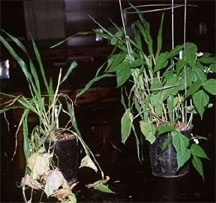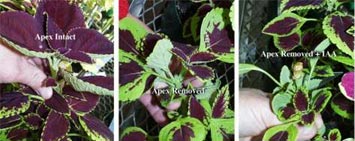Biology: Plant Hormones, Nutrition, and Transport: Part Three
Plant Hormones
A hormone is any chemical produced in one part of the body that has a target elsewhere in the body. Plants have five classes of hormones. Animals, especially chordates, have a much larger number. Hormones and enzymes serve as control chemicals in multicellular organisms.
Auxins
We begin our examination of plant hormones with auxins, the first group of plant hormones to be discovered. During the 1870s, Charles Darwin and his son examined the process of phototropism. They concluded that some influence was causing the curving of the plant stem toward a light. This influence was identified and named after a series of experiments by the Dutch plant physiologist Frits Went in 1926. Went experimented with coleoptiles (sheaths that cover the emerging shoots of grasses). He cut off coleoptile tips and placed them on agar. When an agar block was placed to one side of a decapitated coleoptile, the coleoptile curved away from that side regardless of the direction of the incoming light. The process even happened in the dark. Went concluded that the influence that the Darwins' noted was a chemical that caused curved growth. He named the chemical “auxin” after the Greek word auxein (to grow). Auxin moves to the darker side of the plant, causing the cells there to grow larger than corresponding cells on the lighter side of the plant. This produces a curving of the plant stem tip toward the light, a plant movement known as phototropism. Auxins were the first plant hormones to be identified. They also occur in bacteria, fungi, and animals.
Auxin is a plant hormone produced in the stem tip. Auxins promote cell and stem elongation. Auxins are produced in the stem, buds, pollen, embryos, and root tips. Indole Acetic Acid (IA) is the most common and most active naturally occurring plant auxin. Synthetic auxins, such as 2,4-D (known by the name 2,4-dichlorophenoxyacetic acid) are relatively cheap to manufacture and selectively kill broad-leafed dicots, while not affecting monocots. Use of these synthetic auxins revolutionized weed control in agriculture. The chemical defoliant used during the Vietnam War, Agent Orange, also contained 2,4-D. The manufacture of 2,4-D involved an extremely toxic substance, dioxin, which has led to long-term health issues effecting both American and Vietnamese people.

Two pots, each planted with bean and corn seeds. The pot on the right was sprayed with a water solution. The pot on the left was sprayed with an auxin (2, 4-D).
Auxin also plays a role in maintaining apical dominance. Auxins inhibit the growth of lateral buds. This maintains the apical dominance of the stem tip. Most plants have lateral (sometimes called axillary) buds located at nodes (where leaves attach to the stem). Buds are embryonic meristems maintained in a dormant state. Auxin maintains this dormancy. As long as sufficient auxin is produced by the apical meristem, the lateral buds remain dormant. If the apex of the shoot is removed (by a browsing animal or a scientist), the auxin is no longer produced. This will cause the lateral buds to break their dormancy and begin to grow. In effect, the plant becomes bushier. When gardeners trim a hedge, they are removing the apical dominance-enforcing shoot tips. This allows the axillary buds to break dormancy and bush out the plant.

Apical dominance experiments with coleus plants. The control plant on the left has its apex intact. The plant in the middle has had its apex removed, allowing the growth of lateral shoots. The plant on the right has had its apex removed, but IAA auxin has also been applied, maintaining the apical dominance.
Auxins also promote fruit development. Developing seeds in fertilized flowers produce increasing amounts of auxin. The higher hormone levels stimulate growth of the flower ovary wall to produce fruit. The ripening of the fruit is controlled by another plant hormone, ethylene. Applying synthetic auxins can create seedless varieties of cucumbers and tomatoes. The artificial auxins mimic natural auxins produced by seeds that are not present.
Yet another application of auxin is to delay abscission, the dropping of older flowers, fruits, and leaves. Auxin interacts with other plant hormones in this plant process. Various synthetic auxins can be applied to mimic the normally high levels of auxin produced by young leaves. This will delay the aging of the plant and premature fruit drop.
Now go on to the next part. 
|